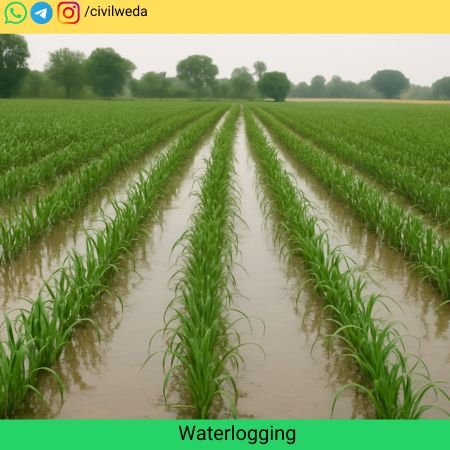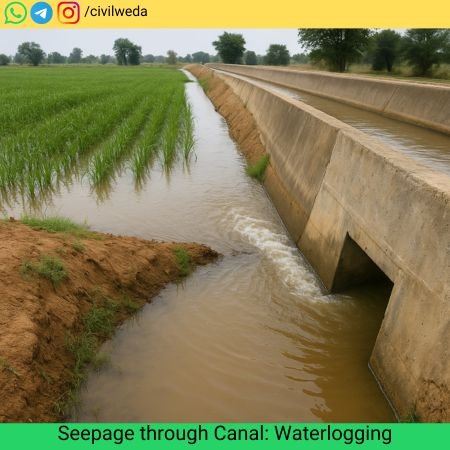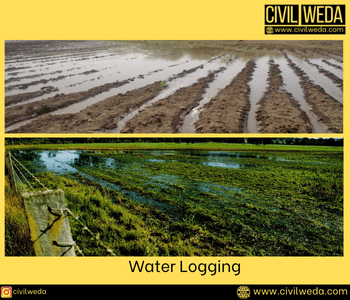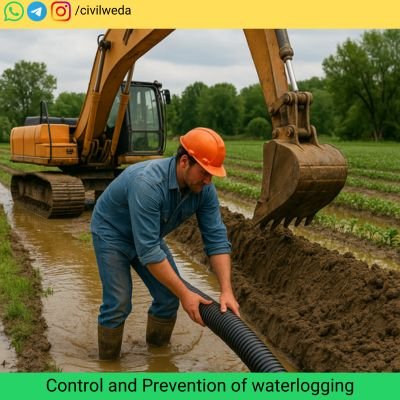Introduction

Waterlogging is a condition where the soil becomes saturated with excess water, leaving little or no space for air in the root zone. As a result, plant roots cannot breathe, crop growth is restricted, and soil productivity declines. Waterlogging is a serious problem in many agricultural regions, especially in countries like India where irrigation plays a major role in farming. Poor drainage, over-irrigation, and canal seepage are some of the most common reasons behind this issue.
This article explains the causes of waterlogging, its harmful effects, and the control measures that engineers and farmers can adopt to prevent it.
What is Waterlogging?
According to wikipedia Waterlogging is a condition when the soil becomes full of water and does not have enough space for air. This usually happens when the water table rises very close to the ground surface. Because of this, plant roots cannot get oxygen, which is essential for their growth.
In short:
- Too much water in the soil = less air for roots.
- Crops cannot grow properly.
- Long-term water logging also damages soil fertility and increse salanity in soil.
Factors Responsible for Waterlogging

- Inadequate Surface Drainage
When the land is poorly graded, surface water cannot move freely. If proper drainage channels are absent or blocked, rainwater and irrigation water collect on the soil surface, resulting in water logging. - Seepage from Canals and Reservoirs
Unlined or poorly maintained canals allow water to seep into surrounding soil. Over time, this seepage raises the groundwater table and affects nearby agricultural fields. - Over-Irrigation
Farmers often supply more water than crops actually need. This extra water percolates downwards and continuously raises the water table, creating conditions for waterlogging. - Obstruction of Natural Drainage
Natural streams, small rivers, or wetlands act as natural drains. Encroachment, urbanization, or lack of maintenance can block these drainage paths, reducing the natural capacity to remove excess water. - High Rainfall with Low Infiltration
In regions with heavy rainfall and soils having low infiltration capacity (like clayey soils), water accumulates on the surface and leads to waterlogging. - Soil and Topography Conditions
Flat topography and fine-textured soils (such as clay) slow down water movement and prevent deep percolation, which contributes to waterlogging.
Effects of Waterlogging
1. On Soil

- Reduces soil aeration, making it unsuitable for root respiration.
- Increases salinity and alkalinity in long-term cases.
- Leads to loss of soil fertility and structure.
2. On Crops
- Roots rot due to lack of oxygen, leading to stunted growth.
- Delayed sowing and poor germination in affected fields.
- Crop yield reduces drastically, sometimes leading to complete failure.
3. On Human and Environment
- Creates breeding grounds for mosquitoes and other insects, causing health issues.
- Damages infrastructure like roads and buildings due to water stagnation.
- Reduces land value and limits future agricultural productivity.
Control and Prevention of waterlogging

- Improving Surface Drainage
Constructing proper surface drains and providing gentle land slopes help excess water to flow away. - Subsurface Drainage
Installing underground drainage pipes removes excess groundwater and lowers the water table. - Canal Lining and Maintenance
Lining canals with concrete or impermeable material reduces seepage losses and prevents surrounding areas from waterlogging. - Controlled Irrigation
Modern irrigation techniques such as sprinkler and drip irrigation provide only the required amount of water, avoiding over-irrigation. - Crop Management
Growing salt-tolerant and deep-rooted crops can reduce the negative impact of waterlogging. Crop rotation also helps in improving soil condition. - Rainwater Harvesting and Groundwater Management
Storing excess rainwater in tanks and ponds reduces surface accumulation and helps recharge groundwater in a controlled manner.
Conclusion
Waterlogging is a serious environmental and agricultural challenge. It damages soil, reduces crop yields, and creates long-term problems for land productivity. Effective drainage systems, controlled irrigation methods, and proper crop planning are essential to manage this problem. By adopting sustainable water management practices, engineers and farmers can protect soil fertility and ensure long-term agricultural success.
Requently Asked Questions on Waterlogging
Q1. What is water logging?
Waterlogging is the saturation of soil with excess water, leaving no space for air in the root zone.
Q2. What are the main causes of water logging?
The main causes are inadequate drainage, canal seepage, over-irrigation, heavy rainfall, and poor soil/topography conditions.
Q3. How does water logging affect crops?
It reduces oxygen supply to roots, delays germination, decreases yield, and may cause crop failure.
Q4. How can water logging be prevented?
By improving drainage, lining canals, adopting controlled irrigation, and practicing crop rotation.
🙏 Thank you for your time! If this helped you, share it with friends and check out more articles on Civilweda for civil engineering study notes.

